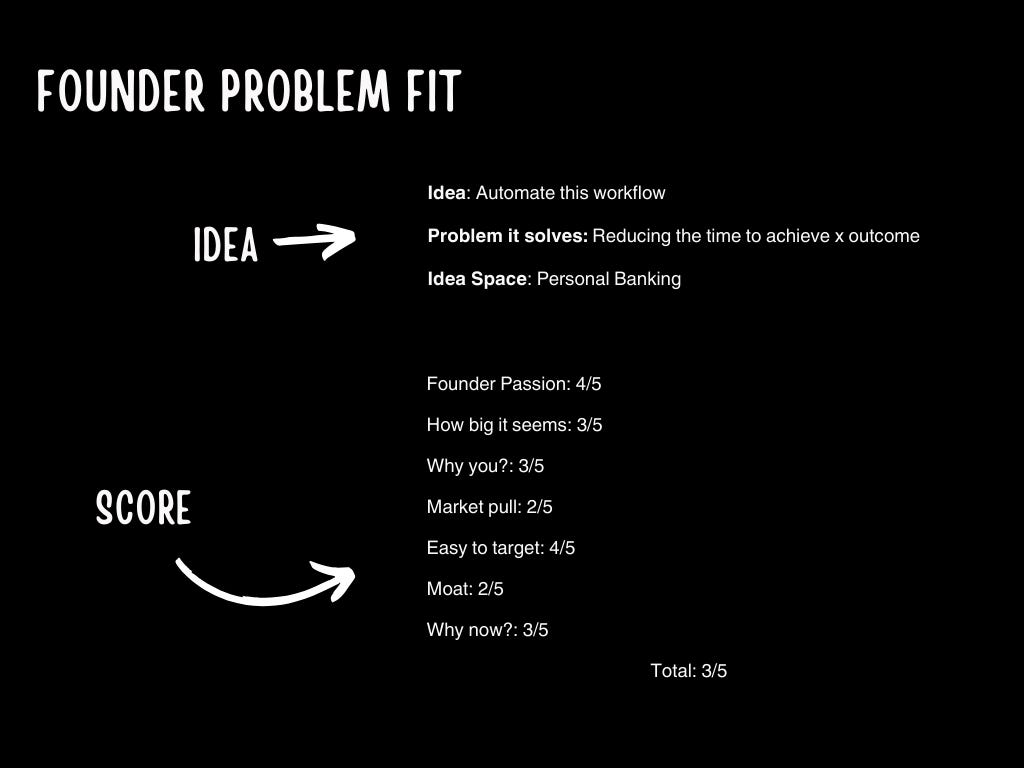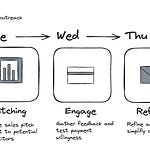Chances are, you're on the brink of choosing the wrong startup idea – this post will guide you on how to beat the odds and select the right one.
In the final days of Lasso, we created this framework to evaluate new ideas for us to pivot to. Since then, I have refined the framework to distill insights from YC Startup School, top-tier VCs, and sales experts like Alex Hormozi. It's most useful when you need to shortlist ideas quickly, seek alignment with a co-founder on a new venture, or when standing at a crossroads ready to pivot. Here is the LinkedIn post I originally shared on the topic.
The scorecard
I have created a Google Sheet Template specifically for scoring with a co-founder; if you want that template, respond to this email with ‘Template’ or in the comment section.
Scoring rationale
💡Problem, Idea, and Idea Space
Idea: What is your hypothesis for solving this problem
Problem: What is the problem that it solves, and for whom? What quantitative impact does it have?
Idea space: What idea space is this in? i.e., if this idea or problem didn’t work out, what game are you in, and what areas can you pivot into?
🔥 How passionate are you about this area?
Audience Resonance: Think deeply about the audience you aim to serve. Does spending time on this problem and this audience give or take energy from you?
Passion isn't just a feel-good factor; it's the driving force that propels you beyond the competition. In what ways will this idea make you hustle harder than the competition?
Identifying Your Passion Project: My favorite question to help people uncover this is to ask;
What business, if you created it, would make your friends and colleagues say, “Of course they started that company; that’s exactly them.”
For an additional perspective, ask someone you worked closely with before, ‘what venture do they see you thriving in?’
📈 What is your Initial Market Size?
Look for markets with significant growth potential, ideally around 20% or more. This is one of the most important signals.
⚡️Why now? (Change/Inflection Event)
One of the biggest challenges you face with any new product is overcoming customer inertia, so inflection points create a breakpoint for you to leverage.
Think of how Uber leveraged the rise of smartphones and GPS technology. That's the power of an inflection point; people always wanted to get to their destination faster, easier, and cheaper, but before these inflection points, it wasn’t possible to create a solution that was 10x better than the existing one.
While AI is currently a significant inflection point, legal and regulatory changes can create substantial opportunities.
🏆 What is your Unfair Advantage?
What Sets You Apart: What do you know or have that less than 1% of the people in the same market have?
🎯 How Easy Is It to Reach This Audience?
If finding people to do user interviews with is challenging, consider the implications for market access. You need to ensure your target audience is reachable and receptive.
🔎 Is There a Strong Market Pull?
Below are the most common ways to gauge if people want what you are building.
Financial Commitment: Sales and pre-orders are the most direct indicators of demand.
Engagement and Trust: Are they using something you built, or have they trusted you with something valuable to start solving, e.g., their data?
Market Data: Look at existing incumbents' sales data, web traffic, and subscription counts.
Listening to Feedback: Customer reviews and testimonials on G2, Capterra, etc, can guide your understanding.
External Indicators: Keep an eye on market trends and competitor actions.
Essential Tools: Utilize resources like GummySearch, Similarweb, Google Trends (+Glimpse), Annualreports.com, AHRefs, Exploding Topics, Trends, BigSpy, Hexowatch, AnswerThePublic, and SparkToro for comprehensive market analysis.
🏰 How Strong is Your Hard-to-Copy Advantage or Network Effects?
While initially less critical, consider how your business might develop a defensible, unique advantage over time.
Network effects: Network effects are mechanisms in a product or business where every new user makes the product, service, or experience more valuable to every other user. They are important because they are the best form of defensibility and value creation in the digital world, responsible for 70% of all the value created in technology since 1994.
A working example
🛠️ Problem:
It takes too much time to write content that I am happy to publish to improve my personal brand.
💡 Idea Spaces:
Ghostwriting, content production, workflow automation
💡 Idea:
A writing assistant for executives, transforming rough notes into publishable content on professional networks while retaining the user's unique tone.
🔥 Passion Level (3.5):
Thrive on empowering individuals to share influential information globally.
⚡️ Change Event (4):
Advancements in LLMs have simplified the communication of complex ideas. As content has become commoditized, people have started looking for thought leaders to curate content.
🎯 Ease to Target (3.5):
95% of my network are knowledge workers.
🌍 Market Size (2.5):
Despite a lot of knowledge workers, many lack the incentive to invest in personal branding due to status quo bias.
🔎 Demand Signals (2.5):
Ghostwriter services exist but are often tied to PR offerings; few seek standalone branding services.
🏆 Unfair Advantage (3.5):
My expertise in personal branding for Fortune 500 executives and software development equips me to build a sought-after solution.
🏰 Moat (1):
This is likely to become easier to do with later releases from OpenAI
Conclusion
As we've explored, this framework is a guide, offering a subjective lens through which to view your startup ideas. At its core, it's about self-awareness, understanding your strengths, weaknesses, and aligning with your co-founder on the vision and direction of the venture. The most significant factor in this journey is the idea and how well it resonates with you and your team's capabilities and passions.
What criteria or resources do you rely on to validate demand for a new idea? Have you found specific strategies more effective in aligning with your co-founder or team?












